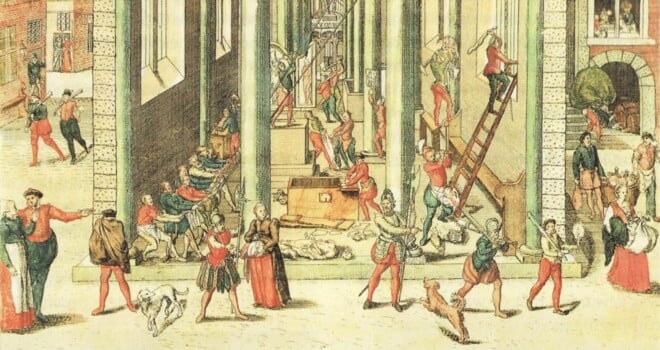John Adams was the second President of the United States. He was also a man of his time who lived in a very anti-Catholic country. As such he was unsympathetic to the Catholic faith by heredity, creed, and conviction. However, he did attend Mass on occasion, and his writings about these visits show attraction mixed with repulsion.
In 1774, Adams attended Mass at the very beautiful St Mary’s in Philadelphia. He wrote to his wife:
Here is everything which can lay hold of the eye, ear, and imagination. Everything which can charm and bewitch the simple and the ignorant. I wonder how Luther ever broke the spell.
Adams was raised a Congregationalist. Like most Protestant sects, their houses of worship were stripped down and very plain, with little or no ornamentation at all. Someone therefore observed: “The pageantry and power of traditional Catholicism obviously had an impact upon Adams although he was loathe to admit it.”
Why were the Protestant meeting houses so plain and devoid of beauty? Because 200 years before John Adams was born, the Protestant Revolution broke loose in Europe and a wave of destruction ensued.
The Dutch word coined for the destruction was Beeldenstorm. The German word is Bildersturm. It translates as statue storm. Another term used at the time was the Iconoclastic Fury; iconoclasm meaning the smashing of icons—icon being a Greek word for religious images.
Statue storms occurred all over 16th century Europe, a century that saw Catholic churches pillaged, ransacked, and burned. Statues, paintings, altars, gold, and brass fixtures—whatever didn’t go up in smoke was destroyed or carted off. Thousands of gorgeous stained-glass windows were smashed. If the church building was confiscated for Protestant worship, then clear glass went up to replace the stained glass. Catholic art in hospitals, monasteries, and the public square was also destroyed by mobs or by government sanction. Centuries of Catholicity was lost overnight to the Beeldenstorm.
What sheer madness. The faithful must have thought the world was ending.
Speaking of madness, the Jews in a recent gospel passage must have thought Christ had gone mad; He was in Jerusalem, sitting up on the Mount of Olives, staring across the valley at the temple—the glory of the Jewish nation, one of the most beautiful buildings in the world. Massive and spectacular, awash in polished marble and gold, everything about the temple evoked permanence. And Christ had just said that it was going to be destroyed. Not a stone of it would be left standing. That was the first line of chapter 13 of Mark.
Christ’s prophecy had to utterly confound his Jewish listeners. They believed that when the Messiah came, an everlasting earthly kingdom would be set up in Jerusalem. To say that the temple would be destroyed was the same thing as saying the world would end. And that’s what Christ was saying.
Chapter 13 of Mark is one long discourse about the end of the world, about the heavens and the earth passing away, and about surviving the coming tribulation. Now, consider the very last word of chapter 13. It is “Watch.” It is a warning from Christ to be on the look-out, to be always ready, to keep the commandments and be in a state of grace for the day He returns.
When will that be? That is what the apostles asked back in verse 4. And Christ basically said, I’m not telling you. Why would I do that? That would ruin all the action. Instead, I’ll give you signs. In the meantime, don’t listen to false prophets who twist my words. Instead, endure till the end. Those who fail to do that, those who fail to keep the commandments, those who run off with the rest of the passing away world, will be eternally damned.
Was Christ bluffing? Well, consider: This was his farewell speech before He hung on the cross. Would He have bluffed at a time like that? We know He wasn’t bluffing because He combined two prophecies and one of them has already been fulfilled. You see, about forty years after Christ died, the temple was leveled to the ground! In 66 AD the Jews started a violent revolution. In 70 AD the Romans, in the ultimate Beeldenstorm, rained hell down on Jerusalem. Thousands died of famine, hunger, and the sword, and the holy city went up in smoke, including the temple. The Jewish nation effectively ended right there. Their world was over. There has not been Jewish sacrifice in the temple since. For as St Paul wrote, there is no more need of it. Priests slaughtering animals does not atone for sin.
Christ’s prophecy of the temple’s destruction is a sign, a pledge from God. He is telling us: You believe the first prophecy because it came true. Believe the second one. I am the true temple, who evokes permanence, yet I was destroyed. I was made the perfect sacrifice on Mount Calvary out of perfect love for you. But I rose from the dead. You see, heaven and earth pass away, but I do not. I bought you with my blood on the cross, and I’m coming back for you as your Eternal Judge. So, watch.
We have lived through our own Beeldenstorm in our own unhappy modern age. But this time around it wasn’t Protestant mobs that smashed statues and altars; it was more of an inside job. This Beeldenstorm, this Iconoclastic Fury kicked into high gear in the 1960’s, and it ran parallel to the Sexual Revolution that completely leveled the moral order. Centuries of Catholicity were lost overnight.
The arguments for the mass destruction of beautiful churches were that the Church needed updating for modern times, and that the 2nd Vatican Council (1962-65) called for the destruction. These were of course false arguments.
Listen to an outmatched and very distressed Pope Paul VI in 1968:
A cause of even greater worry is the behavior of those who contend that liturgical worship should be stripped of its sacred character and who therefore erroneously believe that no sacred objects or ornaments should be used, but the objects of common, everyday use should be substituted. Their own rashness leads some so far that they do not spare the sacred place of celebration. Such notions, we must insist, not only distort the genuine nature of the liturgy, but the true meaning of the Catholic religion.
We’ve had a “Beeldenstorm in reverse” at our parish, a Counter-Beeldenstorm. We’ve renovated and restored. And in doing so, we’ve brought in things that evoke permanence. You see, the world passes away, but Christ’s truth remains permanent. It does not change with the times. We should ask ourselves then, living as we do in a very anti-Catholic world: Am I going to be a person of my time or of God’s time?
Let’s not listen to the false prophets who sell cheap grace and fake mercy; those who try to convince us that Christ was bluffing. Let’s live and die for Christ, by always being in a state of grace, and on the watch when He comes for us. Let’s be sympathetic to the Catholic faith by heredity, creed, and conviction. Let’s endure to the end, and so survive the coming tribulation.
Image from Wikimedia Commons










